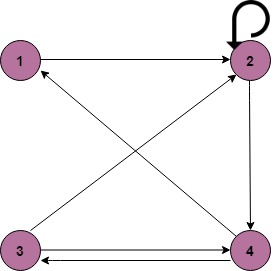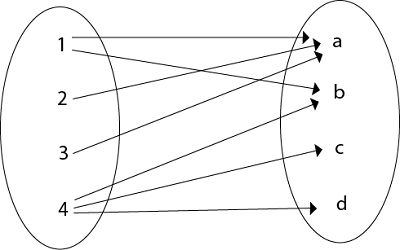Representation of Relations
Relations can be represented or expressed in many pictorial or tabular forms. Some of which are as follows:
Relation as a Matrix
Let A = {a1, a2, a3, ......, an} and
B = {b1, b2, b3, ......, bm} are two finite sets, containing n and m number of elements respectively. Form a rectangular array whose rows are labeled by the elements of A and whose columns are labeled by the elements of B. R is a relation from A to B and can be represented by n x m matrix X = [Xij], defined as
Xij = 0 if (ai, bj) ∉ R
Xij = 1 if (ai, bj) ∈ R
Example :
Let A = {1, 2, 3}, B = {a, b, c}
and R = {(1, a), (1, c), (2, b), (3, a), (3, b)}
The matrix of relation R is represented as
Relation as a Directed Graph
There is another way of picturing a relation R when R is a relation from a finite set to itself. First we write down elements of the set, and then we draw an arrow from each element x to each element y whenever x is related to y.
Example :
Let A = {1, 2, 3, 4}
and R = {(1, 2), (2, 2), (2, 4), (3, 2), (3, 4), (4, 1), (4, 3)}
The directed graph of relation R is represented as
Relation as an Arrow Diagram
If A and B are two finite sets and R is a relation from A to B. Write down the elements of A and B in two disjoint ellipses, and then draw an arrows from a ∈ A to b ∈ B whenever a is related to b.
Example :
Let A = {1, 2, 3, 4}, B = {a, b, c, d}
R = {(1, a), (2, a), (3, a), (1, b), (4, b), (4, c), (4, d)}
The arrow diagram of relation R is represented as
Relation as a Table
If A and B are finite sets and R is a relation from A to B. Make a table whose rows are labeled by the elements of A and whose columns are labeled by the elements of B. Then place a cross (X) in the boxes which represent relations of elements on set P to set Q.
Example :
Let A = {1, 2, 3, 4}, B = {a, b, c, d}
R = {(1, a), (1, c), (2, b), (2, d), (3, b), (3, c), (4, a)}
The table of relation R is expressed as




Comments
Post a Comment